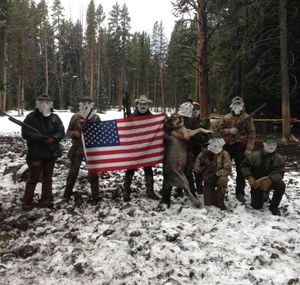Court reinstates endangered status for Wyoming wolves
UPDATE: Wyoming governor responds to ruling.
ENDANGERED SPECIES — Federal protections for gray wolves in Wyoming were reinstated today after a judge invalidated the U.S. Fish and Wildlife Service’s 2012 statewide Endangered Species Act delisting of the species, according to Earthjustice.
The ruling from the U.S. District Court halts the management of wolves by Wyoming, a state with a history of anti-wolf policies.
In overruling U.S. wildlife officials, the federal judge restored protections for wolves but left intact a determination that the species has recovered and is not endangered or threatened "in a significant portion" of its northern Rocky Mountains range.
So the yo-yo effect of wolf management continues, partly because Wyoming took the wolves-are-vermin approach to post endangered-species wolf management.
This situation is similar to what an Idaho wildlife manager was referring to in my Sunday Outdoors story about state management of wolves and elk:
“We’ll be monitoring wolves as a native big-game animal just as we manage mountain lions and black bears,” said Wayne Wakkinen, Idaho Fish and Game Department regional wildlife manager in Coeur d'Alene, referring to long-range plans for dealing with wolves.
“We hope we can continue to count on the participation of hunters and trappers in harvesting wolves (within federal guidelines). One thing we don’t want is to give someone an avenue to petition wolves again for endangered species status.
“Wolves are on the landscape to stay,” he said.
“The court has ruled and Wyoming’s kill-on-sight approach to wolf management throughout much of the state must stop,” said Earthjustice attorney Tim Preso. “Today’s ruling restores much-needed federal protection to wolves throughout Wyoming, which allowed killing along the borders of Yellowstone National Park and throughout national forest lands south of Jackson Hole where wolves were treated as vermin under state management. If Wyoming wants to resume management of wolves, it must develop a legitimate conservation plan that ensures a vibrant wolf population in the Northern Rockies.”
Earthjustice represented Defenders of Wildlife, Natural Resources Defense Council, the Sierra Club and the Center for Biological Diversity in challenging the Fish and Wildlife Service’s September 2012 decision to strip Endangered Species Act protections from gray wolves in Wyoming. The conservation groups challenged the 2012 decision on grounds that Wyoming law authorized unlimited wolf killing in a “predator” zone that extended throughout most of the state, and provided inadequate protection for wolves even where killing was regulated.
“Today the court affirmed that delisting gray wolves in Wyoming by the Obama administration was premature and a violation of federal law,” said Defenders of Wildlife President and CEO Jamie Rappaport Clark. “Any state that has a wolf management plan that allows for unlimited wolf killing throughout most of the state should not be allowed to manage wolves. Wolves need to remain protected under the Endangered Species Act until the species is fully recovered. State laws and policies that treat wolves like vermin are as outdated and discredited today as they were a century ago.”
“The decision makes clear that ‘shoot-on-sight’ is not an acceptable management plan for wolves across the majority of the state,” said Dr. Sylvia Fallon, senior scientist and wildlife conservation director at the Natural Resources Defense Council. “It’s time for Wyoming to step back and develop a more science-based approach to managing wolves.”
“The court has rightly recognized the deep flaws in Wyoming's wolf management plan. Wolves in Wyoming must have federal protection until the state gets it right. That means developing a science-based management plan that recognizes the many benefits wolves bring to the region instead of vermin that can be shot on sight in the majority of the state,” said Bonnie Rice of the Sierra Club's Greater Yellowstone Our Wild America Campaign.
“We’re thrilled that protections for Wyoming’s fragile population of wolves have been restored,” said Noah Greenwald, endangered species director with the Center for Biological Diversity. “With Wyoming allowing wolves to be shot on sight across more than 80 percent of the state, there is no way protections for wolves should have ever been removed.”
The 2012 delisting of wolves in Wyoming turned wolf management over to the state, which opened up over 80 percent of its land to unlimited wolf killing and provided weak protections for wolves in the remainder. Since the delisting, 219 wolves have been killed under Wyoming’s management. Prior to the 2012 reversal of its position, the Fish and Wildlife Service denied Wyoming the authority to manage wolves in the state due to its extremely hostile anti-wolf laws and policies.
Background: Up to 2 million gray wolves were living in North America in the 19th century, but the animals were driven to near-extinction in the lower 48 states by the early 1900s. After passage of the federal Endangered Species Act in 1973 and protection of the wolf as endangered, federal recovery programs resulted in the rebound of wolf populations in limited parts of the country. Roughly 5,500 wolves currently live in the continental United States.
In 2008, a federal judge in Montana reinstated federal Endangered Species Act protections for wolves filed by pro-wolf groups to , preventing Idaho, Montana and Wyoming from implementing fall wolf hunts. The courts cleared the way for wolf hunting to begin again in 2009. Another lawsuit stopped wolf hunting in the 2010-2011 seasons, but the states complied with rules and reopened hunting in the 2011-2012 seasons -- adding regulated trapping to try to bring down wolf numbers that had soared.
The U.S. Fish and Wildlife Service is currently proposing to remove Endangered Species Act protection for most gray wolves across the United States, a proposal that the pro-wolf groups strongly oppose; a final decision could be made later this year.
- See today's report on the court ruling by the Association Press.

